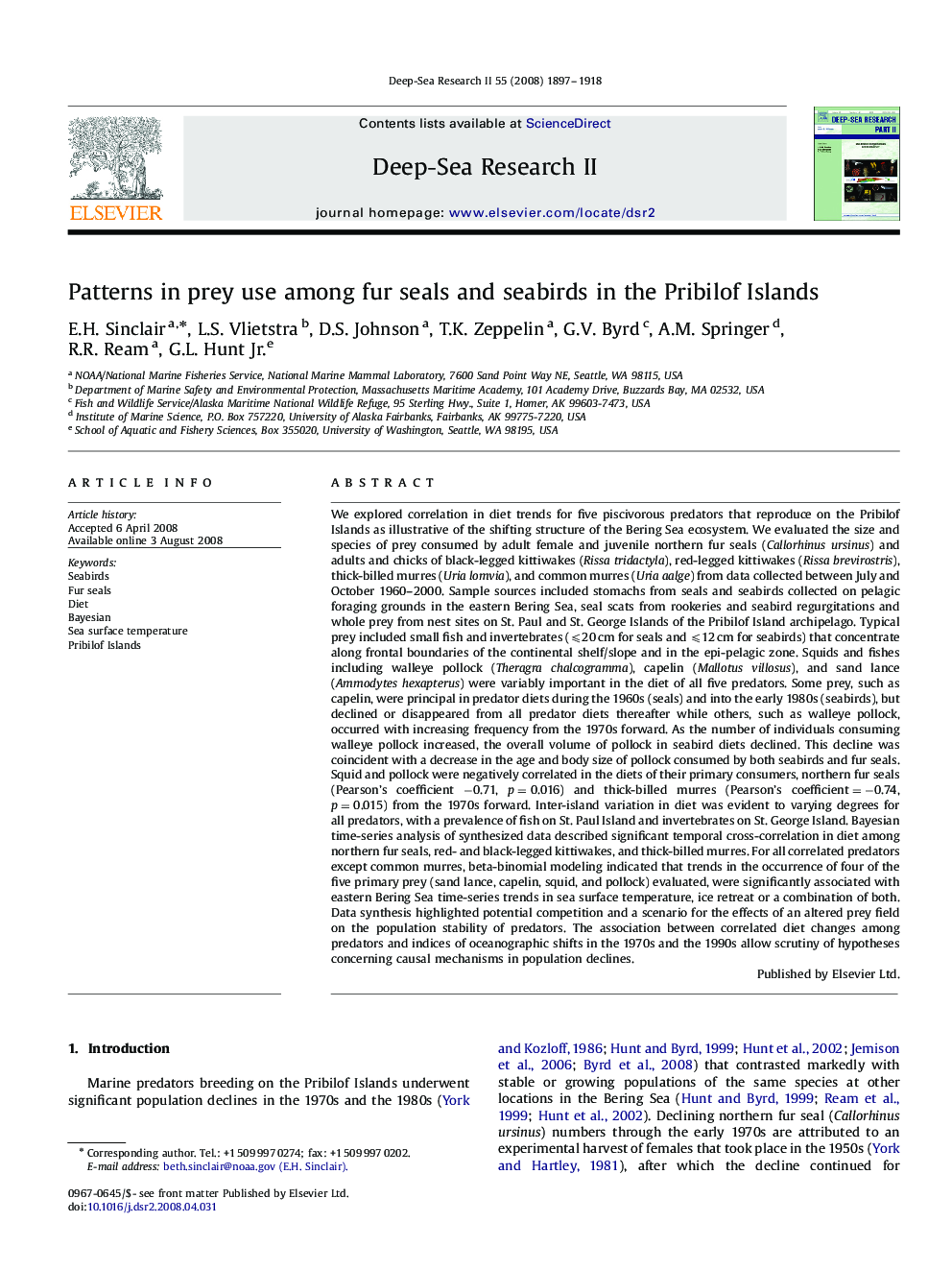| کد مقاله | کد نشریه | سال انتشار | مقاله انگلیسی | نسخه تمام متن |
|---|---|---|---|---|
| 4537402 | 1626493 | 2008 | 22 صفحه PDF | دانلود رایگان |

We explored correlation in diet trends for five piscivorous predators that reproduce on the Pribilof Islands as illustrative of the shifting structure of the Bering Sea ecosystem. We evaluated the size and species of prey consumed by adult female and juvenile northern fur seals (Callorhinus ursinus) and adults and chicks of black-legged kittiwakes (Rissa tridactyla), red-legged kittiwakes (Rissa brevirostris), thick-billed murres (Uria lomvia), and common murres (Uria aalge) from data collected between July and October 1960–2000. Sample sources included stomachs from seals and seabirds collected on pelagic foraging grounds in the eastern Bering Sea, seal scats from rookeries and seabird regurgitations and whole prey from nest sites on St. Paul and St. George Islands of the Pribilof Island archipelago. Typical prey included small fish and invertebrates (⩽20 cm for seals and ⩽12 cm for seabirds) that concentrate along frontal boundaries of the continental shelf/slope and in the epi-pelagic zone. Squids and fishes including walleye pollock (Theragra chalcogramma), capelin (Mallotus villosus), and sand lance (Ammodytes hexapterus) were variably important in the diet of all five predators. Some prey, such as capelin, were principal in predator diets during the 1960s (seals) and into the early 1980s (seabirds), but declined or disappeared from all predator diets thereafter while others, such as walleye pollock, occurred with increasing frequency from the 1970s forward. As the number of individuals consuming walleye pollock increased, the overall volume of pollock in seabird diets declined. This decline was coincident with a decrease in the age and body size of pollock consumed by both seabirds and fur seals. Squid and pollock were negatively correlated in the diets of their primary consumers, northern fur seals (Pearson's coefficient −0.71, p=0.016) and thick-billed murres (Pearson's coefficient=−0.74, p=0.015) from the 1970s forward. Inter-island variation in diet was evident to varying degrees for all predators, with a prevalence of fish on St. Paul Island and invertebrates on St. George Island. Bayesian time-series analysis of synthesized data described significant temporal cross-correlation in diet among northern fur seals, red- and black-legged kittiwakes, and thick-billed murres. For all correlated predators except common murres, beta-binomial modeling indicated that trends in the occurrence of four of the five primary prey (sand lance, capelin, squid, and pollock) evaluated, were significantly associated with eastern Bering Sea time-series trends in sea surface temperature, ice retreat or a combination of both. Data synthesis highlighted potential competition and a scenario for the effects of an altered prey field on the population stability of predators. The association between correlated diet changes among predators and indices of oceanographic shifts in the 1970s and the 1990s allow scrutiny of hypotheses concerning causal mechanisms in population declines.
Journal: Deep Sea Research Part II: Topical Studies in Oceanography - Volume 55, Issues 16–17, August 2008, Pages 1897–1918